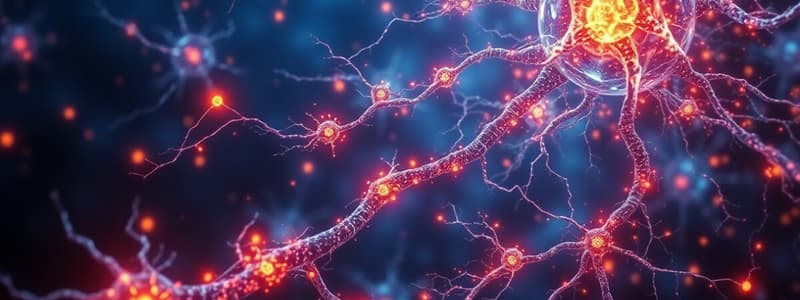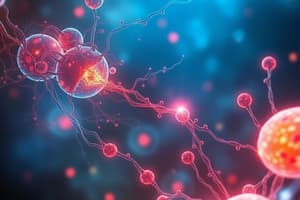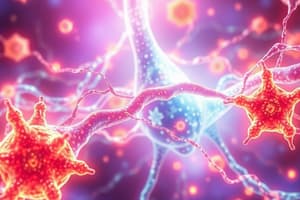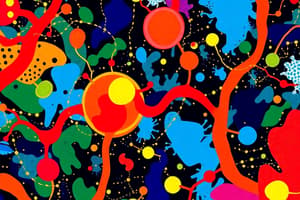Podcast
Questions and Answers
Which of the following is a feature of ionotropic receptors?
Which of the following is a feature of ionotropic receptors?
- They have slow chemical transmission.
- They include ligand-gated ion channels. (correct)
- They primarily function in synaptic plasticity.
- They are G protein coupled receptors.
What is the correct description of neuromodulators in terms of their transmission speed?
What is the correct description of neuromodulators in terms of their transmission speed?
- Even faster than neurotransmitters
- Slow, compared to neurotransmitters (correct)
- Fast, similar to neurotransmitters
- They have variable speeds
Which second messenger system is associated with calcium signaling?
Which second messenger system is associated with calcium signaling?
- cGMP
- phosphatidyl inositol (correct)
- metabotropic receptor
- cAMP
What is a distinct characteristic of metabotropic receptors?
What is a distinct characteristic of metabotropic receptors?
Which of the following accurately represents endocrine signaling?
Which of the following accurately represents endocrine signaling?
What happens after ligand binding to a metabotropic receptor?
What happens after ligand binding to a metabotropic receptor?
Which statement correctly describes the amplified response in metabotropic receptors?
Which statement correctly describes the amplified response in metabotropic receptors?
Which process is directly affected by cyclic AMP signaling?
Which process is directly affected by cyclic AMP signaling?
In the phosphatidyl inositol signaling system, what are the second messengers produced?
In the phosphatidyl inositol signaling system, what are the second messengers produced?
What is the effect of muscarinic Ach receptor activation on cardiac muscle?
What is the effect of muscarinic Ach receptor activation on cardiac muscle?
Which ion channel is involved in cardiac muscle response to muscarinic Ach receptor activation?
Which ion channel is involved in cardiac muscle response to muscarinic Ach receptor activation?
What is the nature of the mechanism by which muscarinic Ach receptors operate?
What is the nature of the mechanism by which muscarinic Ach receptors operate?
Which compound acts as an agonist for nicotinic Ach receptors?
Which compound acts as an agonist for nicotinic Ach receptors?
In the context of Ach receptor pharmacology, what is 'vagustuffe' associated with?
In the context of Ach receptor pharmacology, what is 'vagustuffe' associated with?
Which receptor type is associated with direct ion channel gating?
Which receptor type is associated with direct ion channel gating?
What is the role of G proteins in muscarinic Ach receptor function?
What is the role of G proteins in muscarinic Ach receptor function?
Which is a characteristic function of ionotropic receptors?
Which is a characteristic function of ionotropic receptors?
What is the primary characteristic of homo-synaptic plasticity during stimulation?
What is the primary characteristic of homo-synaptic plasticity during stimulation?
What role do NMDA Glu receptors play in synaptic plasticity?
What role do NMDA Glu receptors play in synaptic plasticity?
Which neurotransmitter's release is modulated by enkephalins in the spinal cord?
Which neurotransmitter's release is modulated by enkephalins in the spinal cord?
What does post-tetanic potentiation refer to in homo-synaptic plasticity?
What does post-tetanic potentiation refer to in homo-synaptic plasticity?
How does pre-synaptic facilitation of hetero-synaptic plasticity increase synaptic efficacy?
How does pre-synaptic facilitation of hetero-synaptic plasticity increase synaptic efficacy?
What mechanism leads to pre-synaptic inhibition in hetero-synaptic plasticity?
What mechanism leads to pre-synaptic inhibition in hetero-synaptic plasticity?
What is the effect of postsynaptic diffusion in synaptic plasticity?
What is the effect of postsynaptic diffusion in synaptic plasticity?
In homo-synaptic plasticity, what is the 'residual calcium hypothesis' related to?
In homo-synaptic plasticity, what is the 'residual calcium hypothesis' related to?
Flashcards
mAchR
mAchR
Muscarinic acetylcholine receptor that inhibits cardiac muscle.
Ionotropic receptor
Ionotropic receptor
Receptor that directly gates ion channels, allowing for fast neurotransmission.
Metabotropic receptor
Metabotropic receptor
Receptor that activates G proteins, leading to slower, indirect effects.
Nicotinic AchR
Nicotinic AchR
Signup and view all the flashcards
Muscarinic AchR
Muscarinic AchR
Signup and view all the flashcards
Agonists
Agonists
Signup and view all the flashcards
Antagonists
Antagonists
Signup and view all the flashcards
G protein
G protein
Signup and view all the flashcards
G Protein Coupled Receptors
G Protein Coupled Receptors
Signup and view all the flashcards
Second Messenger Systems
Second Messenger Systems
Signup and view all the flashcards
Synaptic Plasticity
Synaptic Plasticity
Signup and view all the flashcards
Cyclic AMP signaling system
Cyclic AMP signaling system
Signup and view all the flashcards
Phosphatidyl Inositol signaling system
Phosphatidyl Inositol signaling system
Signup and view all the flashcards
Homo-synaptic Facilitation
Homo-synaptic Facilitation
Signup and view all the flashcards
Homo-synaptic Potentiation
Homo-synaptic Potentiation
Signup and view all the flashcards
Homo-synaptic Depression
Homo-synaptic Depression
Signup and view all the flashcards
Residual Calcium Hypothesis
Residual Calcium Hypothesis
Signup and view all the flashcards
LTP (Long Term Potentiation)
LTP (Long Term Potentiation)
Signup and view all the flashcards
NMDA Glu Receptor
NMDA Glu Receptor
Signup and view all the flashcards
Hetero-synaptic Plasticity
Hetero-synaptic Plasticity
Signup and view all the flashcards
Enkephalin
Enkephalin
Signup and view all the flashcards
Study Notes
Cell Signaling and Neurotransmission
- Neuromodulation and neurotransmission involve ionotropic and metabotropic receptors.
- G protein-coupled receptors (G proteins) are central in pharmacology, affecting skeletal muscle, heart, and the central nervous system (CNS).
- Neurotransmission is a fast process, while neuromodulation is slower.
Second Messenger Systems
- Cyclic nucleotides (cAMP and cGMP) and other molecules like phosphatidyl inositol, Ca2+/calmodulin, and protein kinases are components of second messenger systems.
Synaptic Plasticity
- Homo-synaptic and hetero-synaptic plasticity are key aspects of synaptic function, influencing the efficacy of neuronal communication.
Endocrine Signaling
- Hormones are released directly into the bloodstream.
- Neurosecretory cells release hormones locally.
- Paracrine signaling involves local communication between cells.
- Autocrine signaling involves a cell signaling to itself.
Ligand-Gated Receptors
- Ionotropic receptors directly affect membrane potential (Vm) through ion channels.
- They are gated by ligands, mediating fast chemical transmission.
Metabotropic Receptors
- Metabotropic receptors are G protein coupled receptors that bind to ligands.
- The ligand binding activates G proteins.
- The activated G proteins influence second messenger systems and protein kinases that affect cellular processes.
- Metabotropic receptors exhibit slower chemical transmission and modulation.
Acetylcholine (ACh) Receptor Pharmacology
- Ionotropic (nicotinic) receptors bind directly to ion channels.
- Nicotine is an agonist; curare and bungarotoxin are antagonists.
- Metabotropic (muscarinic) receptors engage in indirect signaling through G proteins.
- Muscarine is an agonist; atropine and scopolamine are antagonists.
- ACh receptors (both types) have roles in the central nervous system (CNS).
Acetylcholine (ACh) Receptor Pharmacology: Heart
- Metabotropic (muscarinic) ACh receptors, found in cardiac muscle, indirectly regulate heart rate.
- They do this by slowing down heart rate.
- Otto Loewi's “vagustuffe” experiment illustrated neurotransmitter communication.
Acetylcholine (ACh) Receptor Pharmacology: Sympathetic Ganglion
- ACh receptor subtypes (ionotropic nicotinic) and (metabotropic muscarinic) are critical in the autonomic nervous system.
- Ionotropic receptors induce fast excitation.
- Metabotropic receptors activate or inhibit slower signaling pathways.
Neurotransmission vs Neuromodulation
- Ionotropic receptors involve ligand binding to receptors that directly alter membrane potential.
- Metabotropic receptors involve ligand binding that activates G proteins to modulate cellular processes.
G Protein-Coupled Receptors
- G protein-coupled receptors (GPCRs) have seven transmembrane domains that bind and mediate signals.
- Activated G proteins can activate enzymes, alter ion channels, and affect second messengers.
Cyclic AMP Signaling
- Cyclic AMP (cAMP) is a second messenger in cell signaling.
- Adenylyl cyclase catalyzes cAMP production.
Phosphatidyl Inositol Signaling
- This system uses inositol triphosphate (IP3) and diacylglycerol (DAG) as second messengers.
- Key player in cellular calcium signaling.
Other Biochemical Systems
- cGMP (cyclic GMP) is involved in photoreception, and Ca2+/calmodulin is a prevalent signaling component.
Synaptic Plasticity (Homo-synaptic)
- Facilitation, potentiation, and depression refer to the changes in synaptic strength.
- This refers to changes in synaptic strength at a single synapse.
- These changes are influenced by calcium levels in the nerve terminal.
- This relies on changes in calcium levels that alter neurotransmitter release.
Synaptic Plasticity (Hetero-synaptic)
- Hetero-synaptic plasticity involves an interneuron affecting synaptic transmission.
- Pre-synaptic facilitation enhances neurotransmitter release.
- Pre-synaptic inhibition reduces neurotransmitter release.
Enkephalin in Spinal Cord Modulation of Pain
- Enkephalin is a pain-modulating neuropeptide.
- It inhibits substance P release, which mediates pain signals.
- Pain stimuli trigger substance P release, and spinal interneurons release enkephalin to reduce substance P transmission.
Studying That Suits You
Use AI to generate personalized quizzes and flashcards to suit your learning preferences.




